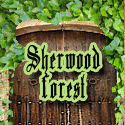© Richard Carpenter 2002
This features Richard "Kip" Carpenter's original hand-written notes for the Robin of Sherwood format and charts the defining of characters, settings and objectives, most of which made it to the final programmes.
For ease of reading we have 'translated' the documents and included ideas and notes that Kip had second thoughts about using. These ideas are denoted in brackets and together with the rest of the document give an alternative view of how the series may have been presented.
For PC users the original can be downloaded and printed off via this link.
www.networkvideos.co.uk/extras.html
[link is not active]
Our thanks go to Richard Carpenter and Abbie Bernstein for making this available.
We have to create a group of strongly (defined) individual young people whose belief in freedom and the English spirit is almost fanatical. A spirit (of) that can (make a man) lead a man to kill himself rather than be captured. It is the (freedom of animals) instinctive physical need of a wild animal. They are nervous young wolves watching and watchful. They are not at all hearty.
I have deliberately kept the dialogue to a minimum. Perhaps because I see it so clearly - I haven't written up stage directions in enough detail. But it is not enough to tell the story with pace and a sense of drama. The characters must exist in a magical ambience yet at the same time be very much more real than actors in costume. (They must think medieval) They must believe in superstition and magic. We must see it in their eyes.
This Robin Hood isn't surface swash and buckle - it's kill or be killed and hit and run. It's the image of a man lying buried and bleeding within a suit of armour. It's panting for breath in the undergrowth with rain lashing down and the soldiers moving nearer. It's fear of the dark, of ghosts and gods and demons. It is belief in spells and curses, in the power of stones and the evil eye. It is the hope that the tree, blasted by winter, will live again. It is living as part of the landscape itself and sharing a forest pool with deer the young wolves will hunt tomorrow.
If the director's imagination can bring this world, this atmosphere and feeling to life then we will succeed in creating a (Robyn Hude) Robin Hood that can excite the modern audience. It is more than the look of the thing. We have to go back in time. (I want to see) The characters must be set against the vivid and changeable English countryside. (1 want photography as it is. Not) a Black Park backdrop; but woods and fields and sky; hills, valleys and streams; crags and reed choked meres; sunlit forest paths and dripping caves.
(I have deliberately made them all very young because the situation) It seems very important to make Robin Hood and his men very young, with Marion little more than a girl. Even the Sheriff and his brother the Abbot should not be more than thirty. This will help to point up Herne who should be the oldest character (in the series) and even He should suggest a man (capable of) of physical (and not an old dodderer). He is after all Herne the Hunter. (and) Although he represents a Merlin character in our story we should avoid the clichés of the "old magician". Herne's appearance should be wild and mysterious, (and we should believe in his power. He) But he is a (powerful man) man full of power - a powerful man. (He becomes possessed in a mediumistic way) (I believe he is). His madness is the "divine madness" of possession and he has strong E.S.R Robin also has "the power of light and darkness" but he is (untrained and) disturbed by them. In a sense he doesn't know his own strength.
Marion is a difficult part to cast. She is much more than Robin Hood's girlfriend. She must be (physically) agile and, when occasion demands, able to take part in raids (and) captures and escapes with the others.
(We don't want a Marion who is a liability). Although very feminine (she) our Marion must be (one of the gang) physically tough without becoming a "principle boy". It is also difficult to find young actresses with a sense of period. (Where) I think our version should differ from others in the numbers of Robin Hood's men. I have noticed that the (story) adventures don't really need a great army of "merry men" and I think it will be more exciting if the (band) gang is quite small (certainly not more than thirteen, a dozen). Therefore we need to rethink the "battle" at the end of the second episode. I think too that a small group against the might of the Anglo Normans (gives us much more the / us more exciting) suggests a guerrilla operation. Also we can get to know a small group (and) so that everyone is a character. Also (and this is a bit esoteric - if we have Robin + twelve and Marion we have a coven).
So we should have Robin, Marion, Little John, Friar Tuck, Will (the only character) Scarlet, Much the Miller's son and four more one of whom can be Alan a dale who will join the gang in episode three or four. (This man) This will make the "merry men" much more of wieldy a unit and somehow more believable. What I've always found hard to take is those before where about eight extras stand around while Robin Hood and the other principles act in front of them.
(Visually I think Wolfshead got it right but I think there were other things about David Butler's conception that were wrong.) I would like to (see the show) hear the dialogue played fast and very "out" whenever possible. Underacting can be as ham as over acting. It's a question of what I call supportive imagination. Laid back performance will not work in this context (it's the difference between Charlton Heston and Dirk Bogarde). It makes the whole thing seem rather silly. Oliver Reed is a (ham actor) good example of (ham) modern ham. his trick is to breathe every line as if he is suffering from laryngitis. Consequently he is either in B.C.U. or the post synched perspective is false. He can wear costume though!







